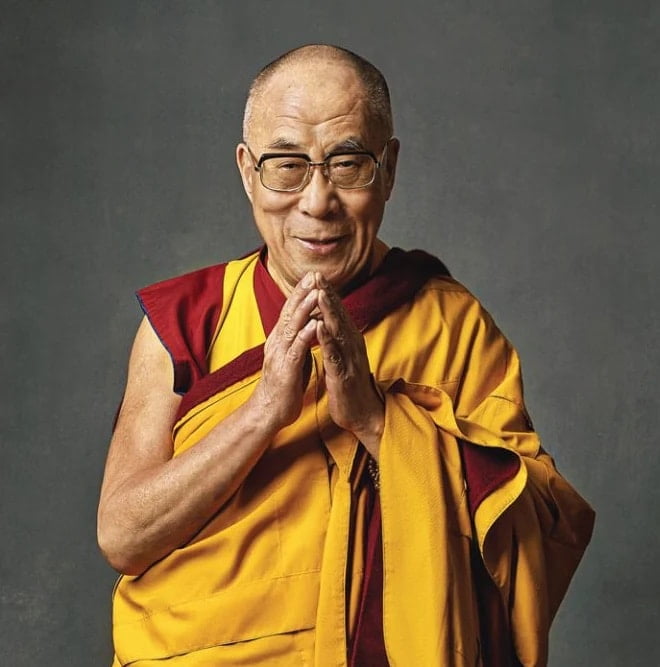Lama is the Tibetan title for a teacher of the Buddhadharma. The word is a contraction of the phrase བླ་ན་མེད་པ་, lanamé pa, meaning supreme, or unsurpassable (Skt. anuttara). Tibetan texts also sometimes explain the contraction “la ma” with the syllable “la” meaning “highest” and the “ma” syllable meaning “mother”. This interpretation, emphasizes the close familial bond between student and teacher.
Lama was chosen as a translation for the Sanskrit word guru. Its usage occurs in the 8th century Mahāvyutpatti, the official source for Sanskrit-Tibetan terminology. Guru can be either a noun or an adjective in Sanskrit. As a noun, it means a giver of knowledge or a spiritual teacher. As an adjective, guru means heavy or weighty, as in “heavy with spiritual wisdom or knowledge,” or “weighty with the good qualities of scriptures and realization.”
In common usage, lama is used in Tibetan Buddhism as a title of respect for monastic or lay tantric practitioners who are thought to have special qualities. In some traditions, it is reserved to distinguish those who have completed the traditional three-year, three-fortnight retreat or similar intensive practice.
Lamas in the Mahayana Context
Throughout the sutras, the Buddha described the importance of relying on an authentic master. In The Perfection of Wisdom in Eighteen Thousand Lines (Āryāṣṭādaśasāhasrikāprajñāpāramitānāmamahāyānasūtra), the Buddha proclaimed the qualities of a teacher who has mastered the perfection of wisdom. This explanation stresses that this type of teacher is indistinguishable from ultimate wisdom. This teacher is therefore weighty and should be called a guru. The Buddha explained:
Furthermore, Kauśika, a son of a good family or daughter of a good family who goes to others and explicates, teaches, explains, gives a commentary on, and makes clear this perfection of wisdom creates even more merit than that earlier one—so they are rightfully the teacher or the learned fellow spiritual practitioner occupying the position of guru. And why? Here the teacher is not one thing and the perfection of wisdom another. Just the perfection of wisdom is the teacher and just the teacher is the perfection of wisdom, so just the perfection of wisdom should be seen as the teacher. And why? It is because past, future, and present tathāgatas, worthy ones, perfectly complete buddhas have appeared because they have trained in this perfection of wisdom, and any learned fellow spiritual practitioners, or bodhisattvas standing in the irreversible state, have fully awakened to unsurpassed, perfect, complete awakening because they have trained in just this perfection of wisdom.
The Perfection of Wisdom in Eighteen Thousand Lines (Āryāṣṭādaśasāhasrikāprajñāpāramitānāmamahāyānasūtra), 31.57.
Mahayana sutras encourage the student to examine a teacher carefully and to seek out those who embody compassion and wisdom. The Ornament of the Great Vehicle Sūtra (Mahāyānasūtrālaṃkāra), contains a frequently cited list of ten qualities of a dharma teacher.
The Role of Lama in the Vajrayana
An early Indian source that describes the importance of a guru in the Vajrayana tantric context is the second-century CE Fifty Verses of Guru Devotion (Gurupañcāśika). This text is attributed to the great poet/scholar Aśvaghoṣa. He gives direct advice that the lama and the student need to examine each other carefully before committing to a relationship. His verses describe the types of teachers one should avoid. Moreover, he lists the qualities that a tantric guru should display. The rest of the text is devoted to the way one should follow and serve an authentic lama.
On the Vajrayana path, a root lama, or root guru (tsawé lama) is the teacher who has successfully introduced the nature of mind to the disciple. This means that the disciple has experienced at least a glimpse of the ultimate nature. In the secret mantra, it is taught that one can only attain awakening due to the compassionate generosity and guidance of this teacher. One of the preeminent masters of the 20th century, Dilgo Khyentse Rinpoche, explained the reasoning behind this teaching:
Similarly, in the tradition of unsurpassable secret mantra, the guru who is the vajra master is in essence inseparable from all the buddhas of the three times. The guru’s manifestation is of even greater kindness than the buddhas of the three times, since without the guru, even though the buddhas of the three times are present, you will not receive blessings and accomplishments. This means that even if you make an offering to just a single pore of the guru’s body it is much more noble than making offerings to the buddhas of the three times. All the vajra tantra scriptures state repeatedly that simply by succeeding in pleasing the guru, you will please all the buddhas of the three times and receive their blessings. For these reasons, the guru is known as the complete embodiment of the Three Jewels, or as the Fourth Jewel. Understand, therefore, that the guru is more powerful than the buddhas of past, present, and future.
You might wonder if there is anything superior to guru yoga and such practices. The answer is that there certainly is not. Although in the tradition of secret mantra, there is no practice for entering the door of blessings, no dharma superior to the profound path of guru yoga, the guru who teaches us the secret mantra is in fact an emanation of the Teacher, the Lord of Sages.
The Sage Who Dispels Mind’s Anguish: Advice from the Guru, the Gentle Protector Mañjuśrī, on the Means of Accomplishing the Yogas of Śamatha and Vipaśyanā by Dilgo Khyentse Rinpoche, trans. Laura Dainty.
Vajrayana Buddhists explain that all practitioners need a human teacher with whom they can relate. If that teacher is realized and exhibits the qualities described above, then he or she is capable of bringing a student to the full fruition of the path, complete awakening. This unsurpassable kindness is why the root lama is so important.


